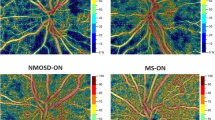Abstract
Optical coherence tomography (OCT) and multifocal electroretinography (mfERG) data using 61 hexagons are presented in three groups of patients: (1) with multiple sclerosis (MS) and optic neuritis (ON) (14 patients), (2) with ON of unknown etiology (19 patients), and (3) with ON of infectious etiology (12 patients). In the patients with MS, the correlation of the latency of the P1 component of mfERG in the parafovea with the retinal thickness in the central zone in all the quadrants of the fundus (except for the superior one) and with the total macular volume has been revealed, which makes it possible to use this mfERG parameter as a marker of MS progression. The results of the current study have demonstrated that the density ratio R1/R x may be used as an additional marker of the acute stage in diagnostic process. Patients with ON of infectious etiology were characterized by a decrease in the retinal thickness in the parafoveal zone of the temporal and inferior quadrants and reduction in the density and amplitude of P1 in all the rings.
Similar content being viewed by others
References
Zavalishin, I.A. and Golovkin, V.I., Rasseyannyi skleroz: Izbrannye voprosy teorii i praktiki (Multiple Sclerosis: Selected Questions in Theory and Practice), Moscow, 2000.
Neroev, V.V., Zueva, M.V., Tsapenko, I.V., et al., Neurodegenerative retinal alterations in relapsing-remitting multiple sclerosis and retrobulbar neuritis: structural and functional parallels, Ross. Oftal’mol. Zh., 2012, no. 4, p. 63.
Peresedova, A.V., Stoida, N.I., Askarova, L.Sh., et al., Results of the study of avonex efficiency in multiple sclerosis, Ann. Klin. Eksp. Nevrol., 2010, no. 3, p. 20.
Romanova, E.V. and Belozerov, A.E., Stereoscopic vision in patients with multiple sclwerosis, Aktual’nye voprosy neirooftal’mologii: mater. V Mosk. nauch.-prakt. neirooftal’mol. konf. (Current Problems of Neuroophthalmology: Proc. V Mosk. Sci. Pract. Conf. Neuroophthalmol.), Moscow, 2001, p. 82.
Shmidt, T.E. and Yakhno, N.N., Rasseyannyi skleroz (Multiple Sclerosis), Moscow: MED press-inform, 2010.
Baseler, H.A., Sutter, E.E., Klein, S.A., and Carney, T., The topography of visual evoked response properties across the visual field, Electroencephalogr. Clin. Neurophysiol., 1994, vol. 90, no. 1, p. 65.
Beck, R.W., Trobe, J.D., Moke, P.S., et al., High-and low-risk profiles for the development of multiple sclerosis within 10 years after optic neuritis: experience of the optic neuritis treatment trial, Arch. Ophthalmol., 2003, vol. 121, no. 7, p. 944.
Fraser, C., Klistorner, A., Graham, S.L., et al., Multifocal visual evoked potential analysis of inflammatory or demyelinating optic neuritis, Ophthalmology, 2006, vol. 113, no. 2, p. 315.
Fraser, C., Klistorner, A., Graham, S.L., et al., Multifocal visual evoked potential latency analysis: predicting progression to multiple sclerosis, Arch. Neurol., 2006, vol. 63, no. 6, p. 847.
Gordon-Lipkin, E., Chodkowski, B., Reich, D., et al., Retinal nerve fiber layer is associated with brain atrophy in multiple sclerosis, Neurology, 2007, vol. 69, no. 16, p. 1603.
Hood, D.C., Odel, J.G., and Zhang, X., Tracking the recovery of local optic nerve function after optic neuritis: a multifocal VEP study, Invest. Ophthalmol. Visual Sci., 2000, vol. 41, no. 12, p. 4032.
Hood, D.C., Ohri, N., Bo, Yang E., et al., Determining abnormal latencies of multifocal visual evoked potentials: a monocular analysis, Doc. Ophthalmol., 2004, vol. 109, no. 2, p. 189.
Klistorner, A., Graham, S., Fraser, C., et al., Electrophysiological evidence for heterogeneity of lesions in optic neuritis, Invest. Ophthalmol. Visual Sci., 2007, vol. 48, no. 10, p. 4549.
Klistorner, A.I., Graham, S.L., Grigg, J.R., and Billson, F.A., Multifocal topographic visual evoked potential: improving objective detection of local visual field defects, Invest. Ophthalmol. Visual Sci., 1998, vol. 39, no. 6, p. 937.
Lamirel, C., Newman, N.J., and Biousse, V., Optical coherence tomography (OCT) in optic neuritis and multiple sclerosis, Rev. Neurol., 2010, vol. 166, no. 12, p. 978.
Matthews, B., Compston, A., Ebers, G., et al., Symptoms and sings of multiple sclerosis, McAlpine’s Multiple Sclerosis, London: Churchill Livingstone, 1998, p. 186.
Ruseckaite, R., Maddess, T., Danta, G., et al., Sparse multifocal stimuli for the detection of multiple sclerosis, Ann. Neurol., 2005, vol. 57, no. 6, p. 904.
Sadovnick, A.D. and Ebers, G.C., Epidemiology of multiple sclerosis: a critical overview, Can. J. Neurol. Sci., 1993, vol. 20, no. 1, p. 17.
Saidha, S., Syc, S.B., Ibrahim, M.A., Eckstein, C., et al., Primary retinal pathology in multiple sclerosis as detected by optical coherence tomography, Brain, 2011, vol. 134, p. 518.
Saidha, S., Syc, S.B., Durbin, M.K., et al., Visual dysfunction in multiple sclerosis correlates better with optical coherence tomography derived estimates of macular ganglion cell layer thickness than peripapillary retinal nerve fiber layer thickness, Mult. Scler., 2011, vol. 17, no. 12, p. 1449.
Trapp, B.D. and Nave, K.A., Multiple sclerosis: an immune or neurodegenerative disorder?, Annu. Rev. Neurosci., 2008, vol. 31, p. 247.
Author information
Authors and Affiliations
Corresponding author
Additional information
Original Russian Text © V.V. Neroev, E.K. Eliseeva, M.V. Zueva, V.S. Lysenko, M.N. Zakharova, I.V. Tsapenko, N.A. Semenova, T.O. Simaniv, 2014, published in Annaly Klinicheskoi i Eksperimental’noi Nevrologii, 2014, Vol. 8, No. 2, pp. 22–26.
Rights and permissions
About this article
Cite this article
Neroev, V.V., Eliseeva, E.K., Zueva, M.V. et al. Demyelinating optic neuritis: Optical coherence tomography and multifocal electroretinography data correlation. Hum Physiol 42, 879–884 (2016). https://doi.org/10.1134/S0362119716080090
Published:
Issue Date:
DOI: https://doi.org/10.1134/S0362119716080090




